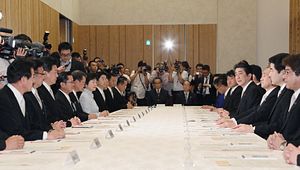With the Liberal Democratic Party’s (LDP’s) seemingly steady hold on power, Japanese Prime Minister Shinzo Abe is on track to become Japan’s longest-serving prime minister. However, according to LDP rules, he cannot serve four conservative terms as party president and so, unless the rules are changed, he will have to step down as prime minister in September 2021. Abe could opportunistically call a lower house snap election between now and then, but this past Sunday was the last upper house election (which are held every three years) before his term ends.
Though an across-the-board LDP victory was assumed given the lack of viable opposition parties, there were still some surprises in individual races. Most significantly for a post-Abe future, some newcomers running on the LDP ticket backed by Chief Cabinet Secretary Yoshihide Suga did well, while four incumbent LDP politicians backed by LDP Policy Research Council Chairman Fumio Kishida lost.
Kishida is most famous to international audiences for having served as Abe’s foreign minister, with a number of key domestic and foreign policy successes, including the “comfort women” deal with South Korea’s Park Gyun-hye administration in December 2015 and U.S. President Barack Obama’s visit to Hiroshima in May 2016. Two years ago, Kishida stepped down from the position to become the party’s policy chief, an important position within the LDP.
But in a nationwide public opinion poll conducted in late May by Asahi Shimbun, asking respondents to rank their preferred successor to Abe, Kishida was behind Koizumi Shinjiro (29 percent), Ishiba Shigeru (17 percent), and Suga (6 percent). At 4 percent, Kishida was tied with current Foreign Minister Kono Taro and Seiko Noda. This nationwide poll – over two years before the party elections – is not a very useful tool for predicting the future, not least because it surveys all Japanese while the LDP elections will be restricted to party members. However, it does indicate that if Kishida is serious about replacing Abe, he will have to work hard to increase his national profile and image in the next two years.
While some of the election results were surprising, given the usual incumbency advantage, they are not decisive in any way for the ongoing intra-party struggle for LDP leadership in the post-Abe era. More important will be the line up of Abe’s new Cabinet, which is expected sometime in September. Suga and Taro Aso, who holds both the positions of deputy prime minister and finance minister, are likely to stay on as they have been strong Abe allies since the beginning of the second Abe administration. Much attention will be paid to Abe’s decisions about Kishida and Toshihiro Nikai, LDP secretary general.
Abe will be relying on Aso and Suga to smoothly implement the consumption tax hike planned for this October, and continuing policies to spur economic growth. Though much of the post-election analysis has focused on how the results affect prospects for constitutional revision, which is a key Abe administration goal, it doesn’t mean other problems have gone away. Upcoming on Abe’s agenda is the Group of Seven meeting in France in late August, and possibly a visit to Vladivostok to meet with Russian President Vladimir Putin in early September.

































